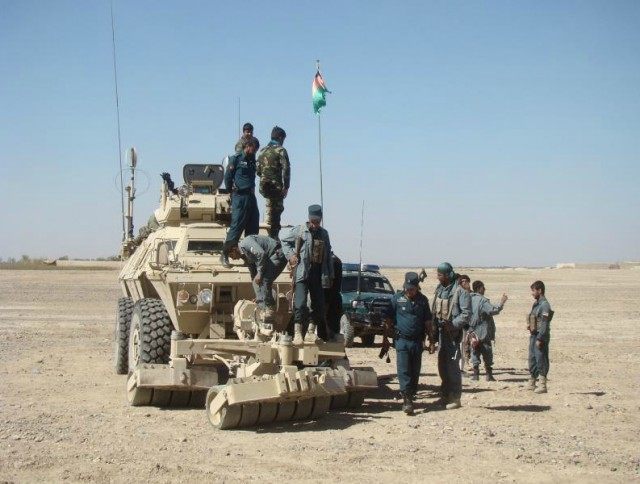At least 70 members of the U.S.-trained and equipped Afghan security forces handed over their weapons and equipment, purchased with American taxpayer funds, and surrendered to the Taliban in the restive district of Sangin in southern Afghanistan’s Helmand province along the Pakistan border.
Although some news reports suggest that the Afghan National Defense and Security Forces (ANDSF) defected to the jihadist group, the Taliban itself declared that the troops surrendered and laid down their weapons.
The Pentagon would neither confirm nor deny the reports, referring Breitbart News to the U.S. forces in Afghanistan, which did not immediately respond to requests for comment.
“Soldiers from an Afghan army brigade in Station area have joined the Taliban with their equipment and weapons,” said Helmand Governor Mirza Khan Rahimi, noting that a team had been sent to the town of Sangin to investigate the incident, Reuters reports.
However, the Taliban, in a statement posted on its official website Voice of Jihad, said that five Afghan commanders and 65 army soldiers had “repented their mistakes and surrendered to [the] Mujahideen” on Nov. 12.
In addition to five armored personnel carriers (APCs), three mortar tubes, and two Russian SPG-9 Recoilless Guns, the ANDSF members handed over “18 US machine guns, 50 US rifles and a large amount of ammunition and other equipment” when they surrendered, stated Taliban spokesman Qari Yousuf Ahmadi.
The U.S. has invested nearly $65 billion in American taxpayer funds on developing the Afghan security forces since the war started in October 2001.
Afghanistan’s Ministry of Defense (MoD) has denied that its soldiers surrendered to the Taliban in the embattled Sangin district.
“Our troops will never surrender to the enemy,” Dawlat Waziri, MoD spokesman, told TOLOnews.
“There might be some problems. This is war,” he added. “Moving forward and backwards, defending and leaving strongholds can happen in war and they are allowed to do this.”
The ANDSF, which includes army and police units, has reportedly been combating insurgents constantly for the past three weeks in the districts of Lashkar Gah, Marjah, and Nadali in Helmand, part of the longtime Taliban strongholds in southern Afghanistan.
“Although they have so far repelled Taliban efforts to take the provincial capital Lashkar Gah, they have not been able to push back the insurgents decisively from areas around the city,” notes Reuters.
Helmand, located next to Kandahar province, the birthplace of the Taliban, has been one of the deadliest places for U.S. military forces throughout the 14-year-old war. It is the top opium-cultivating province in Afghanistan, providing a lucrative source of income for the Taliban.
Bibi Hanif, mother of a soldier serving on the frontline with the Afghan army, claims her son and his colleagues have been surrounded by the Taliban for 15 days, adding that the Afghan government has done nothing to save them, TOLONews reports.
On Nov. 13, the Taliban said it had conquered two “more check posts,” reports the Long War Journal (LWJ).
Data compiled by LWJ shows that the Taliban either controls of contests nearly half (six) of Helmand’s 13 districts.
If Helmand’s Lashkar Gah falls into the hands of the Taliban, it would be the second provincial capital to do so since the insurgent group was overthrown by the U.S. military in 2001.
In late September, Taliban fighters briefly seized the provincial capital of Kunduz before they were driven from the city by Afghan forces, assisted by the United State military.
“Lashkar Gah is not the only provincial capital facing a direct threat,” notes LWJ. “One month ago, the Taliban pressed an offensive to take control of Ghazni city but failed to do so; Taliban forces remain on the outskirts of the city.”
“Additionally, Tarin Kot, the capital of Uruzgan province, which borders Helmand to the north, is also imperiled,” it adds. “Four of the six districts in Uruzgan are heavily contested by the Taliban.”
Overall, the Taliban either controls or contests 71 of the 398 districts across Afghanistan, according to the date analyzed by LWJ.
A similar analysis by the United Nations revealed that districts that were either considered to be under a “high” or “extreme” threat could be found in nearly 80 percent (27) of Afghanistan’s 34 provinces, showing that the Taliban’s reach is currently greater than at any point since the group was ousted from power by the U.S. in 2001.
Security in Afghanistan has deteriorated since President Obama declared an end to the U.S. combat mission in December 2014, while the country was experiencing record levels of violence at the hands of the Taliban.
By that time, the American troop presence had been reduced to nearly 10,000 from a peak of 100,000 in 2012.
“Jihadist groups have become emboldened as Afghan forces have been unable to prevent the return of the Taliban,” reports LWJ. “Al Qaeda was so confident that it established two training camps, one of them extending for 30 square miles, in Kandahar’s Shorabak district. The US military destroyed the camps during a four-day assault in October.”
Soon after Obama ended the U.S. combat mission, ISIS officially expanded its presence to the Afghanistan region.

COMMENTS
Please let us know if you're having issues with commenting.